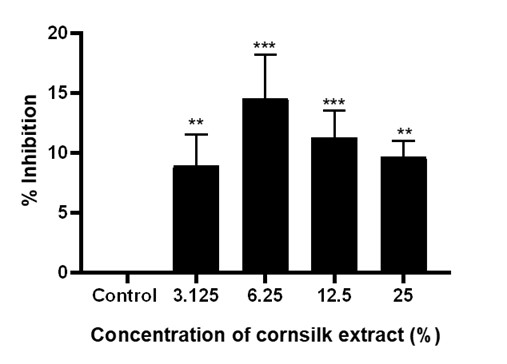Melanin reduction of Corn Silk Extract
Keywords:
สารสกัดไหมข้าวโพด, ฤทธิ์ลดการสร้างเม็ดสีเมลานิน, ฤทธิ์ต้านอนุมูลอิสระ, ฤทธิ์ต้านการอักเสบAbstract
The skin is composed of 3 main layers. Melanocytes in the epidermis layer produce melanin for the skin, eyes, and hair. Additionally, they absorb UV radiation to protect cells from sun damage. While melanin helps to protect the skin abnormal melanin production can cause skin diseases. Currently, pharmaceuticals, dietary supplements, and cosmetics are interested in natural extract. Consequently, there is a trend to explore agriculture by-products such as corn silk. This research aims to study the antioxidant, cell viability, melanin production, and anti-inflammatory in the B16F10 melanoma cell line when stimulated with Corn Silk Extract and In silico. The result shows Corn Silk Extract has shown antioxidant, cytotoxicity at a concentration of 10%, anti-inflammatory, and can also reduce melanin in B16F10 cells at a concentration of 0.3%-1.25%. The analysis of active compounds in Corn Silk Extract using LC-MS/MS found 6 compounds of interest that have the potential for inhibition of tyrosinase in melanogenesis. The result of molecular docking was found that tyrosinase and 6 active compounds can bind by hydrogen bonds. The researcher expects that these active compounds will promote the action of inhibition the melanogenesis.
Downloads
References
อมร บุญสมบัติ. (2559). ผลของวิธีการคั่วต่อสารออกฤทธิ์ทางชีวภาพในไหมข้าวโพดแห้งเพื่อการผลิตชา. วิทยานิพนธ์ปริญญาวิทยาศาสตรมหาบัณฑิต สาขาวิชาเทคโนโลยีการอาหาร บัณฑิต วิทยาลัยมหาวิทยาลัยขอนแก่น.
Boskou, G. (2010). Antioxidant capacity and phenolic profile of table olives from the Greek market. In Olives and olive oil in health and disease prevention (pp. 925-934). Academic Press.
Chan, Y. Y., Kim, K. H., & Cheah, S. H. (2011). Inhibitory effects of Sargassum polycystum on tyrosinase activity and melanin formation in B16F10 murine melanoma cells. Journal of Ethnopharmacology, 137(3), 1183-1188.
Choi, S.Y., Lee, Y., Kim, S.S., Ju, H.M., Baek, J.H., Park, C.S., & Lee, D.H. (2014). Inhibitory effect of corn silk on skin pigmentation. Molecules, 19(3), 2808-2818.
Ebrahimzadeh, M.A., Pourmorad, F., & Hafezi, S. (2008). Antioxidant activities of Iranian corn silk. Turkish Journal of biology, 32(1), 43-49.
Eshwarappa, R. S. B., Ramachandra, Y. L., Subaramaihha, S. R., Subbaiah, S. G. P., Austin, R. S., & Dhananjaya, B. L. (2016). Anti-lipoxygenase activity of leaf gall extracts of Terminalia chebula (Gaertn.) Retz. (Combretaceae). Pharmacognosy Research, 8(1), 78.
Fabian, C.J., Kimler, B.F., & Hursting, S.D. (2015). Omega-3 fatty acids for breast cancer prevention and survivorship. Breast Cancer Research, 17(1), 1-11.
García-Gavín, J., González-Vilas, D., Fernández-Redondo, V., & Toribio, J. (2010). Pigmented contact dermatitis due to kojic acid. a paradoxical side effect of a skin lightener. Contact Dermatitis, 62(1), 63-4.
Hasanudin, K., Hashim, P., & Mustafa, S. (2012). Corn silk (Stigma maydis) in healthcare: a phytochemical and pharmacological review. Molecules, 17(8), 9697-9715.
Kanpipit, N., Nualkaew, N., & Thapphasaraphong, S. (2022). The potential of purple waxy corn cob (Zea mays L.) extract loaded-sericin hydrogel for anti-hyperpigmentation, UV protection and anti-aging properties as topical product applications. Pharmaceuticals, 16(1), 35.
Mayur, B., Sandesh, S., Shruti, S., & Sung-Yum, S. (2010). Antioxidant and α-glucosidase inhibitory properties of Carpesium abrotanoides L. Journal of Medicinal Plants Research, 4(15), 1547-1553.
Miyamura, Y., Coelho, S. G., Wolber, R., Miller, S. A., Wakamatsu, K., Zmudzka, B. Z., ... & Hearing, V. J. (2007). Regulation of human skin pigmentation and responses to ultraviolet radiation. Pigment Cell Research, 20(1), 2-13.
Nawaz, H., Aslam, M., & Muntaha, S. T. (2019). Effect of solvent polarity and extraction method on phytochemical composition and antioxidant potential of corn silk. Free radicals and antioxidants, 9(1), 5-11.
Olivares, C., García-Borrón, J.C., & Solano, F. (2002). Identification of active site residues involved in metal cofactor binding and stereospecific substrate recognition in mammalian tyrosinase. Implications to the catalytic cycle. Biochemistry, 41(2), 679-686.
Rahman, N.A., & Rosli, W.I.W. (2014). Nutritional compositions and antioxidative capacity of the silk obtained from immature and mature corn. Journal of King Saud University-Science, 26(2), 119-127.
Sarepoua, E., Tangwongchai, R., Suriharn, B. O. R. O. N., & Lertrat, K. (2013). Relationships between phytochemicals and antioxidant activity in corn silk. International Food Research Journal, 20(5), 2073-2079.
Tengkaew, S., & Wiwattanadate, D. (2014). Study of source and potential of biomass from field corn in Thailand. Princess of Naradhiwas University Journal, 6(3), 102-111. (In Thai)

Downloads
Published
How to Cite
Issue
Section
License
Copyright (c) 2024 Nakhon Ratchasima Rajabhat University

This work is licensed under a Creative Commons Attribution-NonCommercial-NoDerivatives 4.0 International License.



